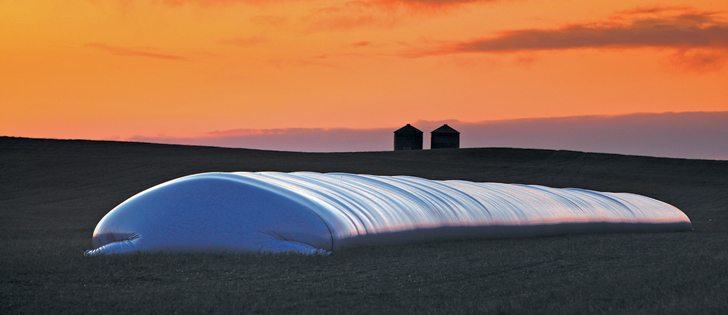That’s the case in the southern Prairies, but bag sales have been brisk in the north, where the crop is larger
Portions of the prairie landscape are not as white as usual this time of year and that’s not a reference to snow.
A poster named Saskfarmer3 on Agriville’s Commodity Marketing forum said he recently drove from Balgonie, Sask., to Brooks, Alta., and could count the number of white grain bags on his fingers and toes.
He believes that is a sign that the canola crop isn’t as big as analysts suggest.
Companies that sell grain bags say this year’s sales are, well, a mixed bag.
Read Also

Using artificial intelligence in agriculture starts with the right data
Good data is critical as the agriculture sector increasingly adopts new AI technology to drive efficiency, sustainability and trust across all levels of the value chain.
“I know for our southern dealers it was definitely way down compared to normal,” said Craig Yeager, owner of GBC Equipment in Humboldt, Sask., a company that sells Hitec grain bags.
That is because drought impacted yields in that region, reducing the need for secondary grain storage.
But the reduced sales in southern Saskatchewan and Alberta have been more than offset by increased sales in the north due to plentiful crops in many regions.
Overall sales are as strong as they were last year when there was a huge crop harvested in Western Canada, said Yeager.
Todd Lewis, president of the Agricultural Producers Association of Saskatchewan, said he has noticed the dearth of bags in the southern part of the province because producers didn’t get the big yields they had in 2013 and 2016.
“The other part is, heck, there’s a lot of steel goes up every year,” he said.
“There’s shiny big bins around the country that I see, that’s for sure.”
Larry Weber of Weber Commodities has analyzed on-farm storage capacity in Western Canada based on Statistics Canada data. It was 71.2 million tonnes as of July 2016, up from 67.7 million tonnes a year earlier. Data for 2017 is not yet available.
He noted that is more than enough storage to handle this year’s harvest of all grains, oilseeds, pulses and special crops in Western Canada, which totalled 66.8 million tonnes.
It is a big crop but not a bumper one like 2016 when farmers produced 72.5 million tonnes or 2013 when they harvested a whopping 77 million tonnes and caught the grain handling and transportation system off guard.
Curtis Chapman, president of Canadian Tarpaulin Manufacturers Ltd., a company that markets IpesaSilo grain bags, said sales are probably down about 10 percent this year but still above the five-year average.
He believes that is because the largest concentration of the company’s business is in and around its headquarters in Saskatoon, where there was no drought.
“That’s maybe why we didn’t feel as big a hit as some of our competitors in the south,” said Chapman.
He said there is a wide range of farmer opinion on using bags versus bins.
“Some people are married to what they’ve done in the past whereas others have switched completely over to grain bags and don’t put any of their crop in the bins,” said Chapman.
Yeager said grain bags aren’t just for secondary storage. Farmers are increasingly using them as a management tool during harvest. They allow busy operators to quickly store grain rather than trucking it back to the home quarter.
“A lot of the guys are using the baggers to get going in the fall,” he said. “They can keep the wheels turning.”
Lewis agreed that bags are a nice temporary storage option.
“It’s a great tool for guys to use. It saves so much time. You get into a heavy crop and it’s difficult to truck that sizable crop,” he said.
Yeager said farmers are also finding bags to be good for straight-cut canola, which has a tendency to heat in bins.
“There is no oxygen in the bags, so it doesn’t heat and it seems to keep the canola better,” he said.
















